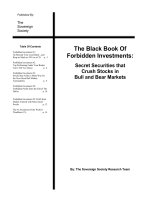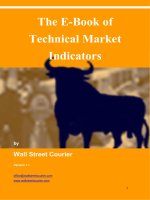Tài liệu The new reality of wall street ppt
Bạn đang xem bản rút gọn của tài liệu. Xem và tải ngay bản đầy đủ của tài liệu tại đây (1.64 MB, 289 trang )
THE NEW
REALITY OF
WALL STREET
This page intentionally left blank.
THE NEW
REALITY OF
WALL STREET
An Investor’s Survival Guide to Triple
Waterfalls and Other Stock Market Perils
Donald G. M. Coxe
McGraw-Hill
New York Chicago San Francisco
Lisbon London Madrid Mexico City Milan
New Delhi San Juan Seoul Singapore
Sydney Toronto
Copyright © 2003 by
The McGraw-Hill Companies, Inc. All rights reserved. Manufactured in the United States
of America. Except as permitted under the United States Copyright Act of 1976, no part of this publication may be
reproduced or distributed in any form or by any means, or stored in a database or retrieval system, without the prior
written permission of the publisher.
0-07-143631-6
The material in this eBook also appears in the print version of this title: 0-07-141753-2.
All trademarks are trademarks of their respective owners. Rather than put a trademark symbol after every occur-
rence of a trademarked name, we use names in an editorial fashion only, and to the benefit of the trademark owner,
with no intention of infringement of the trademark. Where such designations appear in this book, they have been
printed with initial caps.
McGraw-Hill eBooks are available at special quantity discounts to use as premiums and sales promotions, or for
use in corporate training programs. For more information, please contact George Hoare, Special Sales, at
or (212) 904-4069.
TERMS OF USE
This is a copyrighted work and The McGraw-Hill Companies, Inc. (“McGraw-Hill”) and its licensors reserve all
rights in and to the work. Use of this work is subject to these terms. Except as permitted under the Copyright Act
of 1976 and the right to store and retrieve one copy of the work, you may not decompile, disassemble, reverse engi-
neer, reproduce, modify, create derivative works based upon, transmit, distribute, disseminate, sell, publish or sub-
license the work or any part of it without McGraw-Hill’s prior consent. You may use the work for your own non-
commercial and personal use; any other use of the work is strictly prohibited. Your right to use the work may be
terminated if you fail to comply with these terms.
THE WORK IS PROVIDED “AS IS”. McGRAW-HILL AND ITS LICENSORS MAKE NO GUARANTEES OR
WARRANTIES AS TO THE ACCURACY, ADEQUACY OR COMPLETENESS OF OR RESULTS TO BE
OBTAINED FROM USING THE WORK, INCLUDING ANY INFORMATION THAT CAN BE ACCESSED
THROUGH THE WORK VIA HYPERLINK OR OTHERWISE, AND EXPRESSLY DISCLAIM ANY WAR-
RANTY, EXPRESS OR IMPLIED, INCLUDING BUT NOT LIMITED TO IMPLIED WARRANTIES OF MER-
CHANTABILITY OR FITNESS FOR A PARTICULAR PURPOSE. McGraw-Hill and its licensors do not warrant
or guarantee that the functions contained in the work will meet your requirements or that its operation will be unin-
terrupted or error free. Neither McGraw-Hill nor its licensors shall be liable to you or anyone else for any inaccu-
racy, error or omission, regardless of cause, in the work or for any damages resulting therefrom. McGraw-Hill has
no responsibility for the content of any information accessed through the work. Under no circumstances shall
McGraw-Hill and/or its licensors be liable for any indirect, incidental, special, punitive, consequential or similar
damages that result from the use of or inability to use the work, even if any of them has been advised of the possi-
bility of such damages. This limitation of liability shall apply to any claim or cause whatsoever whether such claim
or cause arises in contract, tort or otherwise.
DOI: 10.1036/0071436316
ebook_copyright 5.5x8.5.qxd 8/27/03 9:37 AM Page 1
For Judy
This page intentionally left blank.
Contents
Preface ix
Acknowledgments xi
Prologue 1
1 A Taxonomy of Bears 9
2 Triple Waterfalls 25
3 How Triple Waterfalls Reshape the Landscape 45
4 How Wars Shape Economies and Markets 71
5 Surviving Wall Street’s Predators 89
6 The Dollar and Its Alternatives 101
7 The Expatriate Dollar: The Eurodollar 123
8 The Challenging Financial Landscape Ahead 149
9 Setting Your Course to a Secure Retirement 183
10 Constructing a Survival Pak Portfolio 209
11 Course Corrections and Tips for Staying on the Trail 255
12 Conclusion 263
Index 269
vii
For more information about this title, click here.
Copyright © 2003 by The McGraw-Hill Companies, Inc. Click here for Terms of Use.
This page intentionally left blank.
ix
Preface
Woodcraft may be defined as the art of finding one’s way in
the wilderness and getting along well by utilizing Nature’s store-
house. . . . As for book learning in such an art, it is useful only to
those who do not expect too much of it. No book can teach a man
how to swing an axe or follow a faint trail. . . . Yet a good book is
the best stepping-stone for a beginner. . . . It gives a clear idea
of general principles. It can show, at least, how not to do a
thing—and there is a good deal in that—half of woodcraft, as
of any other art, is in knowing what to avoid.
—H
ORACE K
EPHART
S
O, YOU LOST BIG ON TECHNOLOGY STOCKS, and the same Wall Street
people who told you to buy them and never told you to sell them now tell
you they’re about to come back strong, “when the economy comes back.”
How 20th century of them.
The 1990s aren’t coming back.
Neither is Nasdaq. The stock market that enriched corporate insiders
beyond their wildest dreams and impoverished retail investors beyond their
worst nightmares is no longer rewriting the rules on investing.
Three years of this century have produced three shocks: Technology
and telecom stocks have experienced a crash of 1929 proportions; the
United States fell into a brief recession followed by a problematic recovery,
and a War on Terror began on 9/11. Those three shocks combined to pro-
duce a major global bear market.
And Baby Boomers are three years closer to retirement.
So what should you do now?
Unlike the successful investment books of the 1990s, this is a Survival
Guide. It’s modeled on two splendid wilderness books: Horace Kephart’s
Copyright © 2003 by The McGraw-Hill Companies, Inc. Click here for Terms of Use.
classic Camping & Woodcraft (Macmillan, 1949), and Richard Graves’s
Bushcraft (Warner Books, 1974). Both those guides were for urban
dwellers prepared to assume nature’s risks in order to reap the rewards of
living in the outdoors. They were based on the conviction that wilderness
survival depended on knowing—and using—wisdom accumulated over
generations.
This book is written on the same premise: Investors who knew—and
used—investment wisdom accumulated over generations have come
through the stock market collapse quite comfortably. Those who invested
based on the new rules of the 1990s have been mauled by bears.
As you will learn, the Nasdaq crash is a precise—almost eerie—replay
of six other crashes, including the Great Crash of 1929 and the Nikkei crash
that began 60 years later. Its outcome was totally predictable to students of
market lore. Those big-name strategists and pundits who failed to warn
investors about the coming collapse chose to ignore history.
Because of those past crashes, we know a lot about the financial land-
scape ahead. It bears scant resemblance to the world of the 1990s. It’s rocky
out there, not verdant, but that means reduced cover for bears and other
predators. There are opportunities for prudent foragers, but rewards won’t
come easily.
Wall Street and Silicon Valley got together in an undeclared partner-
ship to wire the world, enrich themselves, and convince a whole new class
of investors into trusting the partners with much of their life savings. It was
a great deal for the partners, but a terrible deal for the investors. Never in
the history of major stock markets were the rewards so skewed to insiders
at the expense of outsiders.
This book will tell you how it happened, why it happened, and what you
need to do to rebuild your savings.
As drab as the investment landscape may appear, it’s safer for investors
than it has been for five years. You didn’t know how risky it was then, and
you probably don’t know how safe it is now. There are no lush and easy
pickings like the crops of the 1990s, but there are fewer poisonous mush-
rooms and fewer bears around the blueberries.
You have learned that good times in the stock market don’t last forever.
You will learn that bad times don’t either.
x
PREFACE
xi
Acknowledgments
T
HIS BOOK SUMS UP what I’ve learned in three decades of institutional
investing. Much of what I picked up came from others—colleagues,
clients, and competitors. I am grateful to them.
I am particularly appreciative of the encouragement and counsel of my
colleagues within the BMO Financial Group. They are too numerous to
mention, but I especially thank Gilles Ouellette, Bill Downe, Bill
Leszinske, Gord Lackanbauer, Brian Steck, Sherry Cooper, Eric Tripp,
Mike Miller, Randy Johnson, Thalia Kingsford, Cindy Holmes, Peter
McNitt, Peter Morris, and Tom Wright.
Those who undertook the arduous task of evaluating the manuscript
deserve special thanks, and I appreciate the comments and suggestions I
received from Margaret Wente, Robert Klemkowsky, Chaviva Hosek, and
Robert Helman. My editor, Kelli Christiansen, not only commissioned the
book but was a great help with her analysis of the material as the book unfolded.
Writing a book of this scope while continuing work as portfolio strate-
gist and fund manager meant reliance on extensive technical and editorial
support. Angela Trudeau as researcher and editorial assistant, Patricia Tre-
ble as fact-checker, and Sandra Naccarato as chartist were wonderful. Any
errors that remain are mine alone.
I have been writing about markets for as long as I’ve been managing
money. That habit comes from the journalism training I got in my first
job—as an Associate Editor at National Review, under the expert supervi-
sion of the Managing Editor, the patient Priscilla Buckley.
Above all, I am thankful for the unstinting support and wise editorial
critiquing throughout this undertaking from my wife, Judy.
Donald G. M. Coxe
Chicago, Illinois
January 2003
Copyright © 2003 by The McGraw-Hill Companies, Inc. Click here for Terms of Use.
This page intentionally left blank.
1
T
HE T
HIRD MILLENNIUM ARRIVED
amid optimism and ecstasy, as lead-
ers in politics, the academy, and business predicted a glorious new
era.
But then, so had the Second Millennium.
The medieval enthusiasts who got themselves into trouble by pre-
dicting the onset of a New Age gave us a new word. They are known to
historians as chiliasts, derived from the Greek word for 1000—the term
for those who believed that the arrival of a special date meant special
wonders.
There were various kinds of cults back then, but all involved an
assumption that Heaven was headed for Earth—for good or ill. Many peo-
ple divested themselves of their possessions in preparation for the Second
Coming.
Those earlier ecstatics were in trouble when the year 1000 came and
went. Those who’d sold out cheaply and had given to the less fortunate were
understandably upset with the mystics who’d misled them. They tended to
express their resentment in strong terms.
It’s different this time—in two ways.
First, although this time millions of people also divested themselves of
all or a substantial portion of their possessions, they didn’t give their wealth
to the poor. They gave it to a new class of new rich. The beneficiaries, with
exquisite timing, exercised stock options on companies they managed
whose period of earnings gains was about to turn into a period of earnings
collapse.
Prologue
Copyright © 2003 by The McGraw-Hill Companies, Inc. Click here for Terms of Use.
Second, most of today’s chiliasts have not been subject to serious
abuse—physically, financially, or legally. Most retain their jobs, which
means they are receiving a new round of stock options at today’s depressed
share prices, so they stand to win big all over again if stocks recover even
modestly. If there is a justification for this process, it comes from words
uttered in the 1st century: “That unto everyone which hath shall be given;
and from him that hath not, even that he hath shall be taken away from
him.”
It took only a few weeks of the new century before the New Era fan-
tasies collided with reality.
Since then, the stock market and economy have been badly beaten up.
Those injuries came from the collective attempt of the stock markets and
economies of the 1990s to defy one law.
Gravity.
At its peak (March 10, 2000), Nasdaq had a stated price-earnings ratio
of 351 (though when the income statements of companies losing money
were included, with stock option costs, its real level was more than 500
times earnings).
It was bound to fall of its own weight. The question was never if but
when. By any measurement, it was—by far—the most absurdly overvalued
stock index in the history of finance. Compare that stratospheric multiple
with three other crashes: U.S. stocks in 1929 and 1987 and Japanese stocks
in 1989. The price/earnings (p/e) ratio on the Dow Jones Industrials at the
onset of the Great Depression was in the high 20s, as it was on October 19,
1987, the day the market fell 22.6 percent; at its peak, the ratio on the Tokyo
Nikkei Index was 92.
Gravity finally took charge. Nasdaq’s Moon shot had carried it so far
from Earth’s pull that when it rolled over and began its descent, it moved
slowly at first. Then, like a space capsule, it accelerated as it reentered the
atmosphere in its plunge toward terra firma.
Those with a respect for history found Nasdaq’s costly meeting with
gravity ironic.
Why?
Because the first recorded crash since the birth of stock markets
inflicted big losses on the man who formulated the law of gravity, Sir Isaac
Newton. What happened to England and to the scientist Einstein called the
greatest mind of all time is instructive.
The South Sea Bubble (1720) was a scheme so preposterous that most
historians still find it hard to explain how so many people could fall for the
idea that a private company—one of the first “joint stock companies”—
2
THE NEW REALITY OF WALL STREET
could make its investors rich by assuming the national debt. Sir Isaac’s
experience tells us what we need to know to understand market manias.
As president of the Royal Society, Newton was at the epicenter of sci-
ence, technology, and London society. As the South Sea enthusiasm spread,
he joined his friends in “taking a flutter” on South Sea shares.
When those shares rose rapidly in value, Newton decided to take a
handsome profit. He had analyzed the scheme and concluded it was, at the
very least, highly risky.
But South Sea shares kept going up, and the conversations in the cof-
feehouses and at Royal Society gatherings were all about the huge profits
his friends and associates were earning from this new phenomenon of joint
stock companies. When Newton admitted he had sold, his friends and fel-
low scientists smirked, bragging of their own huge gains.
He could finally stand the peer pressure no longer, and so he bought
back in as the shares were nearing the magic level of £1000 each. Peer pres-
sure proved to be the irresistible force against what should have been the
immovable object of the world’s most massive intellect.
Newton was among the nation’s biggest losers as the shares crashed to
£135. As he mourned to friends thereafter, he found he could understand
the movement of heavenly bodies but not of markets on Earth.
There was a parliamentary investigation, and the chancellor of the
exchequer (finance minister) and some of the company’s board of directors
were sent to the Tower of London for their parts in what was declared to be
a scheme of fraud.
It was convenient for the bruised egos of those who had lost heavily to
define the whole game as fraud. But it is doubtful that fraud was the key to
the South Sea fiasco. The real cause was the build-up of a critical mass of
optimism, faith, and fanaticism that swept the land, seducing the wise and
foolish alike.
That remains the pattern. In all the great crashes that have succeeded
the South Sea, outright fraud has been a relatively minor component. In
each case, the cry was, “Hang the crooks!” and there were show trials and
punishments.
But in no case, including Nasdaq’s collapse, have most of those
involved been willing to admit that human frailty, not criminality, was the
primary driving force. That these manias recur through history illustrates
Santayana’s dictum that those who will not learn from history are destined
to repeat it.
Which elements of the South Sea Bubble and subsequent crashes
reasserted themselves in Nasdaq?
PROLOGUE
3
■
A new kind of financial instrument. In 1720 it was shares in publicly
traded “joint stock companies” whose prices were widely quoted,
allowing investors to measure the growth in their own wealth—or
how much they were missing out on by not being in.
In the 1990s it was technology stocks; yes, there had been tech
stocks before, but not so many, and not since technology had become
a part of everyday living. They were what they claimed to be: the
Next New Thing. Among the most enthusiastic investors in tech
stocks were those who were the most enthusiastic about technology,
biotechnology, and the Internet.
■
A sense of a New Era being born. In 1720, England had a new king,
and its stature in Europe after the Treaty of Utrecht promised a sus-
tained age of peace, at a time of exciting scientific progress.
In the 1990s, America as victor in the Cold War would preside
over an era of global peace. The new president was no mere Cold
War retread but a forward-looking Baby Boomer, who shared the
enthusiasm, optimism, priorities, and fun-loving style of the Sixties
Generation.
■
In 1720 investors had never experienced a crash, and had the money
to back their bets on a bright future.
The 1990s soon forgot about the Crash of 1987, which had been a
brief flap that did not derail the economy, in part because the general
public was not deeply involved in the stock market. The previous
crash was in 1973–1974, but that was the Nixon crash, and the
Boomers had, at the time, little political power and very little
invested in the stock market.
■
In 1720 the magic appeal was a concept of wealth creation that,
though hard to explain, seemed easy to understand. Its essence was
an entirely new approach, and people wanted to believe that what
was new was automatically good.
In the 1990s what was new was obviously good, even if you didn’t
understand how it worked. Many people who bought shares of, say,
JDS Uniphase or Cisco would have had trouble explaining what the
company actually did; even those who understood their hot products
had only the vaguest idea how technology companies could make
large, sustainable long-term profits in product lines in which there
were few real barriers to entry. As Andy Grove, co-founder of Intel
had written in Only the Paranoid Survive, every night he worried
4
THE NEW REALITY OF WALL STREET
about some guy in a garage who would come up with the killer
invention. Intel had survived several tech boom/bust cycles. Paranoia
was almost nonexistent in the rest of Silicon Valley in this cycle:
Euphoria had crowded it out.
■
In 1720 there was momentum, excitement, and wealth beyond dreams
of avarice. South Sea shares were going up so fast that they swept
doubt before them, and everybody who was anybody was in the game.
In the 1990s tech billionaires were greater heroes than rock
stars or professional athletes; tech billionaires were cool. Young
people labored long hours for tech start-ups, each hoping to be
the next centimillionaire or even billionaire. Nor were these
dreams mere fantasies: For a while, more new billionaires were
being minted in months than had been created in all previous
American history. Nasdaq’s upward momentum blew away doubt
and skepticism.
■
In 1720 there was a virtual unanimity of opinion among the elites
that nothing could go wrong. Although dissent was not banned by
law, peer group pressure among the wealthy commercial class and
the aristocracy was so powerful that almost no prominent people
stood up to ask whether the emperor really had clothes.
In the 1990s, when Warren Buffett, the most successful American
portfolio investor in history, rejected the entire technology industry
as an investment concept, he was derided as old and out-of-date;
ditto for self-made billionaire Sam Zell. Only a handful of academics
challenged the prevailing ethos. Endowment funds of leading univer-
sities switched major percentages of their portfolios into venture cap-
ital investing in start-up companies, and faculties were universally
supportive. If one was with it, one was in it.
■
After the crash, a parliamentary investigation, criminal charges, and
an epidemic of finger-pointing.
And the bleat goes on.
A little more than 280 years after Newton learned that financial
gravity was as powerful a force as natural gravity, the process was
repeated on a grander, global scale.
It had reappeared from time to time during the intervening cen-
turies. In the 19th century there were booms and busts tied to over-
building of canals and railways. In each case, optimism led to
intoxication, leading to a massive hangover.
PROLOGUE
5
Rule I. Gravity always asserts itself. That its assertion produces such
widespread financial ruin comes from investors’ refusal to follow
a rule enunciated by another great scientist. . . .
Rule II. Einstein said that compound interest is the greatest force in
the universe. Compound interest is at the root of successful
wealth building, whether one invests in stocks or bonds. But it
only works as a wealth-builder within reasonable numeric limits.
For example, when the S&P rose more than 20 percent for five
straight years, a feat never before achieved, it raised near-insuper-
able challenges for the next and succeeding years. Nasdaq’s 88
percent leap in 1999 could not be compounded higher, and there-
fore the outcome was reverse compounding—a force as potent as
compounding.
In each of history’s boom-bust cycles, the capital assets built during the
boom fell to values that a new generation of entrepreneurs could use prof-
itably, and a new cycle began.
The Russian economist Nikolai Kondratieff, working in the 1920s,
observed these cycles and constructed an historical pattern of long waves.
He correctly forecast the Great Depression, for which Stalin praised him.
But he then predicted that based on the long waves, capitalism would come
back. Since Stalin had assured his followers that the Depression’s onset sig-
naled the death throes of capitalism, Kondratieff’s forecast was anathema.
He sent the economist to death in Siberia. Kondratieff remains, as far as I
know, the only economist murdered for making an accurate forecast. It is
said (by cynics) that his successors have learned from his example. That
explains why the economic consensus has never predicted the coming of a
recession and why economists have trouble agreeing on when it came and
when it ended. Bearers of bad news used to be beheaded. Now they are just
denied tenure—or attentive audiences.
These major crashes are economically and financially transforming
events, and, as such, are structurally different from the normal bull/bear
blow-offs tied to economic cycles and the normal excesses of fear and
greed.
Each modern replication of this collective rush into the abyss had
enormous effects on the economy and on capital markets. In particular,
each pointed the way to the investment strategies that would be most suc-
cessful . . . not just for ensuing years, but for ensuing decades.
As Churchill said, “The farther backwards you can look, the farther
forward you are likely to see.” This book is meant to be a practical
6
THE NEW REALITY OF WALL STREET
Investor’s Survival Guide, which means its extensive discussion of past
folly is not just history for the curious to savor. It is market lore every
investor can use, like the lore accumulated over centuries that sustains users
of the wilderness.
It will be a long time before the next Triple Waterfall hits the capital
markets. It may be a long time before the next big stock market plunge. In
the meantime, the investment landscape will be littered with both the car-
casses and the opportunities created by Nasdaq’s collapse.
PROLOGUE
7
This page intentionally left blank.
9
The signs animals leave on the ground can be more revealing than
any book written by man, but unfortunately few people are able to
see these signs and even fewer still can read them.
—R. G
RAVES
M
OST INVESTORS LOSE MONEY—and many are wiped out—in bear
markets. This chapter, which could as well have been called the
Investor’s Basic Survival Guide for Bear Encounters, describes the differ-
ent kinds of bears.
It can be a matter of life and death for hikers to know which species of
bears’ territory they are invading. Similarly, investors should learn to dis-
tinguish the kind of bear attacks the market faces.
If you’re in the Rockies, you watch out for black bears and, most impor-
tant of all, grizzlies; in Alaska, you look for kodiaks and polar bears; in
Churchill, Manitoba, you know when the polar bears are coming—by the
hundreds—and you prepare accordingly.
For investors, there are four basic breeds of bears, but one of them
has two subgroups, making five classifications of Furry Financial Furies
altogether.
One reason so many investors get mauled by bears is that Wall Street
not only fails to warn of bear attacks, but even resists labeling a falling
market as a bear market until investor losses have already reached painful
levels.
A Taxonomy of Bears
1
CHAPTER
Copyright © 2003 by The McGraw-Hill Companies, Inc. Click here for Terms of Use.
The Street is like lodge operator who avoids frightening customers by
talking of bear risk. The Street has euphemisms for falling markets: They
begin as “pauses,” then become “pullbacks,” then “corrections.” The Street
forbears saying “bear.”
When Nasdaq was plunging in April 2000, the Street was virtually
unanimous that this was merely a “correction.” I wrote at the time: “The
term ‘correction’ is itself interesting. It implies a change from doing some-
thing wrong to doing something right. . . . Was the stock market wrong
when it went up and right when it went down?”
Maybe so.
The bear groups:
Teddy Bears
Baby Bears
Papa Bears
Mama Bears (Mini and Big)
Despite their seeming playfulness, these are deadly serious classifica-
tions. They can be as crucial for investors’ wealth as the differences in size,
gender, and breed of bear can be for hikers who come upon actual bears.
Why try to classify market slumps into such bear categories?
Because most of the literature on bear markets lumps all downturns
together, and this makes it difficult for novices to understand the nature of
bear risks at any given time.
Know your bear.
TEDDY BEARS
Teddy Bear markets are childishly explosive tantrums. The financial out-
bursts cause temporary fear and pain and look, in retrospect, absurdly over-
done. The stock market may change leadership, but it does not change
direction, because nothing fundamental is involved, and the outburst is not
the culmination of years of speculative excess. Teddy Bears are no picnic;
they resemble playground fights, not gang wars.
The centennial of teddy bears was observed last year. (Ever alert for
a quick buck, The U.S. Postal Service issued four commemorative
stamps.) According to the Chicago Tribune, these toys were named for
Teddy Roosevelt, who, on a bear hunting trip to Mississippi in 1902,
10
THE NEW REALITY OF WALL STREET
failed to bag a bear. The trip sponsors found a bear, lassoed it, and tied it
to a tree, inviting him to shoot it. Teddy shouted “Spare the bear!” and
freed it. A cartoonist drew the scene, depicting a frightened cub. Thus was
born the teddy bear industry, which produces one of the four most popu-
lar collectibles.
Many park rangers see teddies differently. They are appalled that so
many city dwellers raised on furry toys expect bears to be cute. Worse,
there have been cases of tenderfeet finding cubs and trying to pet them,
with horrific consequences.
Since teddy bears are named after a president, it is fitting that this his-
tory of stock market bears begin with accounts of two outbursts tied to
presidents.
The Ike Teddy: September 24, 1955
The Ike Teddy (see Chart 1-1) came when President Eisenhower suffered a
heart attack while vacationing in Colorado bear country. He was
sequestered for seven weeks in Fitzsimmons Army Medical Center. When
he returned to Washington, he reassured the nation that he was in good
health.
A TAXONOMY OF BEARS
11
CHART 1-1 S&P 500 (January 1, 1955 to December 31, 1955)
Data courtesy of Bloomberg Associates.
34
36
38
40
42
44
46
48
Jan-55 Feb-55 Mar-55 Apr-55 May-55 Jun-55 Jul-55 Aug-55 Sep-55 Oct-55 Nov-55 Dec-55
The market’s brief bout of panic produced the biggest stock market
trading volume since 1933. The “reasoning” behind this emotional outburst
was the fear that if Ike died, Vice President Nixon would become president
and would be defeated by a Democrat in the 1956 election. At that time,
Wall Street was dominated by a Wasp, white-shoe, country-club Republi-
can elite. Basically, their fear of Adlai Stevenson, former governor of Illi-
nois (who had run in 1952 and would run again in 1956), was irrational.
The U.S. economy was on a baby-boom roll, and a Democrat in the
White House would not have derailed it.
The JFK Teddy: March 1962
Another onset of Wall Street Demophobia produced the JFK Teddy (see
Chart 1-2).
In March 1972, President Kennedy intervened in the steel industry
contract negotiations. He pressured the United Steelworkers to accept what
he called a noninflationary agreement, which would not only hold back
steel price increases but would be a guide to other big pending labor agree-
ments. (Yes, back then the steel industry was that big and that important to
the national economy.)
12
THE NEW REALITY OF WALL STREET
CHART 1-2 S&P 500 (January 1, 1962 to December 31, 1962)
Data courtesy of Bloomberg Associates.
50
55
60
65
70
75
Jan-62 Feb-62 Mar-62 Apr-62 May-62 Jun-62 Jul-62 Aug-62 Sep-62 Oct-62 Nov-62 Dec-62









